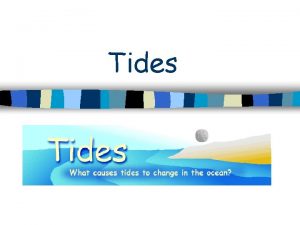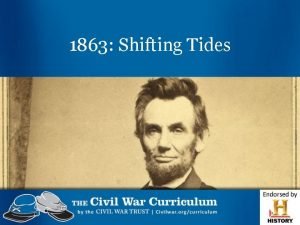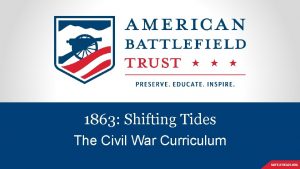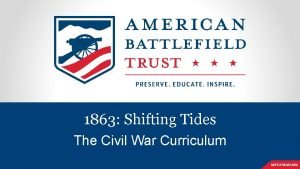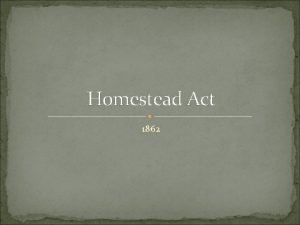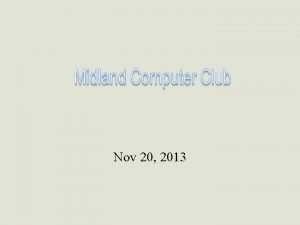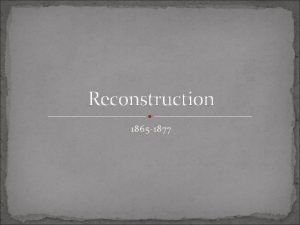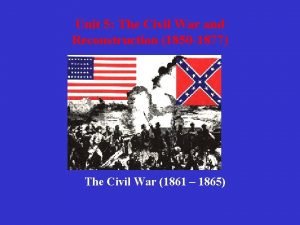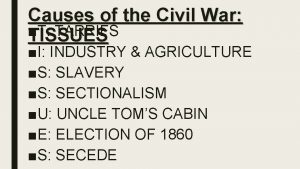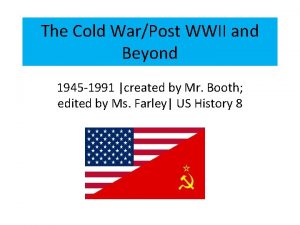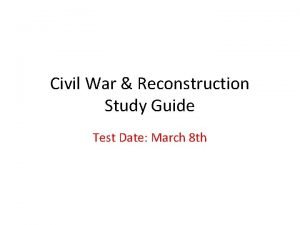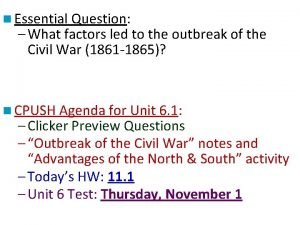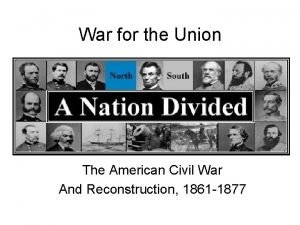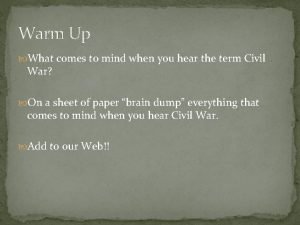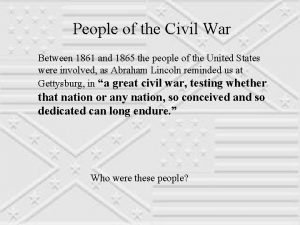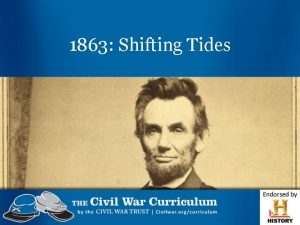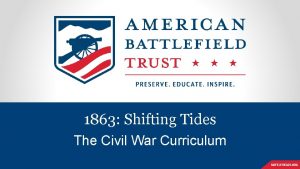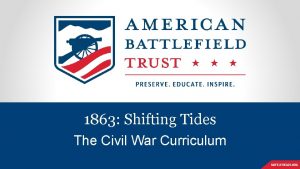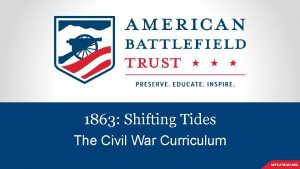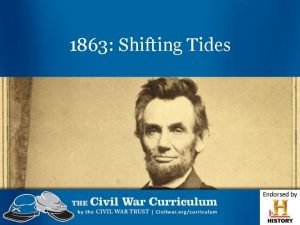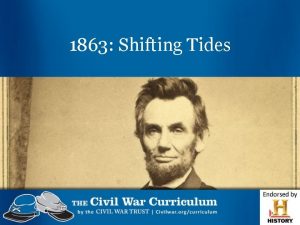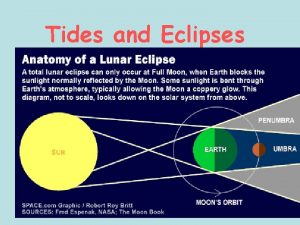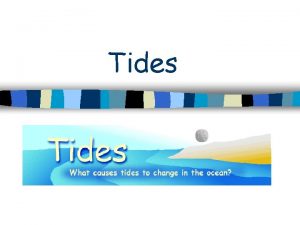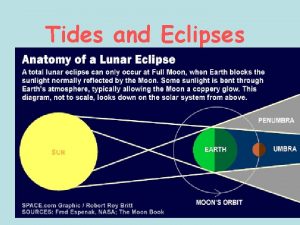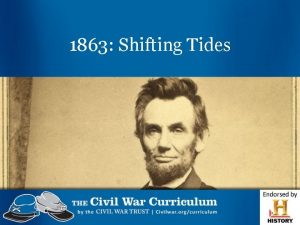1863 Shifting Tides The Civil War Curriculum Shifting


































- Slides: 34

1863: Shifting Tides The Civil War Curriculum

Shifting Tides While the Union won some important battles and was holding a successful blockade, the Confederacy was more successful on the battlefield.

Shifting Tides Confederate success on the battlefield led to high morale among its citizens, whereas in the Union, morale was low.

Shifting Tides The Battle of Antietam and the Emancipation Proclamation, which followed, changed the war, but the citizens of the North began to wonder if the war effort was worth the incredibly high death toll.

Shifting Tides Some of the major battle casualties (people killed, wounded, or lost) leading up to the summer of 1863.

Shifting Tides Activity: On your paper is a list of battles, write the battles in chronological order on your timeline.

Shifting Tides Map Activity: As we discuss each battle you will 1. Highlight the battle on your map indicating which side won. 2. Tally the winners for each battle.

Fort Sumter April 12, 1861 • On April 12, 1861, the Confederate army fired upon Fort Sumter, which guarded the port of Charleston SC. At 2: 30 pm the next day, Union forces surrendered the fort. After this attack President Lincoln called for 75, 000 volunteers. • Make a tally mark under the Confederate Victory column. Find Fort Sumter on your map and highlight it as a Confederate victory.

First Manassas (Bull Run) July 21, 1861 • The first major battle of the Civil War occurred North of Manassas Junction about 20 miles west of Washington, DC. • With 4, 700 casualties everyone realized that the war was not going to be short or easy. • Tally and highlight Manassas as a Confederate victory.

Forts Henry and Donelson February 1862 • Ulysses S. Grant gained control of Forts Henry and Donelson in February 1862. A major victory for the Union, the fall of Forts Henry and Donelson opened up Tennessee and Alabama to Union advances. There were 17, 655 casualties in these battles. • Tally and highlight both forts on your map as Union victories.

Battle of Shiloh April 6 -7, 1862 • Camped at Pittsburg Landing along the Tennessee River, the Union Army, under Maj. Gen. Grant was attacked by Confederate forces under General Albert Sidney Johnston. Ultimately, Johnston was killed and the Confederates were forced to retreat from the bloodiest American battle up to that time with 23, 716 casualties. Shiloh ended Confederate hopes of blocking the Union advance into northern Mississippi. • Tally and highlight Shiloh as a Union victory on your map.

Second Manassas (Second Bull Run) August 28 -30, 1862 • At the Second Battle of Manassas, Robert E. Lee led Stonewall Jackson and James Longstreet as they outmaneuvered Union General John Pope, driving the Union Army back to Washington DC. There were 22, 180 casualties in this battle. • Make a tally mark for the Confederacy. Find Manassas on your map and highlight it as a Confederate victory.

Antietam September 17, 1862 • The battle of Antietam technically ended in a draw, but is considered a strategic win for the Union because the Confederacy withdrew. Following the battle, Abraham Lincoln issued the Emancipation Proclamation. Antietam saw 23, 100 casualties, making it the single bloodiest day in American history. • Make a tally mark for the Union. Find Antietam on your map, and highlight it as a Union victory.

Fredericksburg December 13, 1862 • Following Antietam, the Union sought another victory at Fredericksburg, 60 miles from Richmond. Arriving at the banks of the Rappahannock River, the Union army faced a smaller Confederate army. However, pontoon bridges were needed to cross the river. By the time the bridges arrived, the Confederates had been reinforced and entrenched on high ground. The Union attempted a bloody uphill attack, but was forced back, at a total cost of 17, 929 casualties. • Make a tally mark for the Confederate victory. Find Fredericksburg on your map and highlight it as a Confederate victory.

Chancellorsville April 30 -May 6, 1863 • At Chancellorsville, Robert E. Lee outmaneuvered Union leader Joseph Hooker. Lee took a great risk and divided his army against the much larger Union force. This is considered Lee’s greatest victory, but it cost him his greatest general, Stonewall Jackson. Total casualties are estimated at 24, 000. • Make a tally mark for the Confederate victory. Find Chancellorsville on your map, and highlight it as a Confederate victory.

The situation as the summer of 1863 arrives:

Vicksburg May 18 - July 4, 1863 • In the west, United States military forces under Ulysses S. Grant surround Vicksburg, Mississippi, located at a significant point on the Mississippi River. • On your map locate and circle Vicksburg, Mississippi

Vicksburg A loss at Vicksburg would mean that the Confederate territory would be cut in half.

Vicksburg After 47 days of siege Lt. Gen. John C. Pemberton surrenders Vicksburg to Grant on July 4, 1863. Etching titled, “Cave life in Vicksburg during the siege”

The Vicksburg Campaign Activity: Watch In 4: The Vicksburg Campaign

Gettysburg July 1 -3, 1863 • In the east, Confederate forces under General Robert E. Lee invade the Northern state of Pennsylvania • On your map locate and circle Gettysburg, Pennsylvania

Gettysburg At this point in the war, the Confederate Army of Northern Virginia has a winning record. And Confederate General, Robert E. Lee has a plan to move his army north.

5 Reasons Lee invaded Pennsylvania : 1. to disrupt the Union’s ability to attack the Confederate capital at Richmond, Virginia Gettysburg 2. to draw the United States Army away from the safety of the defenses of Washington, D. C. and fight them in the “open” 3. to take the war away from the farmers in Virginia who were having problems planting and harvesting crops, as both armies had been camping or fighting on their land for the previous two summers 4. to “live off the land” and collect supplies to take back to Virginia 5. to win a decisive victory on Northern soil in the hopes of bringing the Civil War to a close

Gettysburg On July 1 st, 1863 Union forces clash with Lee’s Army

After three days of fighting and 51, 000 casualties killed, wounded, or missing…

Gettysburg • The Confederate Army of Northern Virginia is defeated • Lee and his army leave Pennsylvania and retreat to Virginia. • Never again would the Confederates invade a Northern state in large numbers.

After Vicksburg and Gettysburg: Date Battle Name Causalities Winner April 12 -13, 1861 Attack on Fort Sumter, SC None CSA July 21, 1861 First Manassas a. k. a. Bull Run, VA 4, 700 CSA Feb. 11 -16 1862 Fort Henry/Fort Donelson, TN 17, 655 USA April 6 -7, 1862 Shiloh a. k. a. Pittsburg Landing, TN 34, 445 USA August 28 -30, 1862 Second Manassas aka Second Bull Run, VA 22, 180 CSA Sept. 17, 1862 Antietam a. k. a. Sharpsburg, MD 23, 100 USA Dec. 13, 1862 Fredericksburg, VA 17, 929 CSA April 30 -May 6, 1863 Chancellorsville, VA 24, 000 CSA July 1 -3, 1863 Gettysburg, PA 51, 000 USA May 18 – July 4 1863 Siege of Vicksburg, MS 19, 233 USA

The Aftermath In the United States In the Confederate States The victories at Gettysburg and Vicksburg increased the morale of the United States and its armies. Many people now feel that the war can be won. The losses at Vicksburg and Gettysburg decrease the morale of the Confederate States and its armies. For most of the remainder of the war the Confederates will fight on the defensive.

The Aftermath Activity: Watch In 4: Battlefield Death

The Aftermath On November 19, 1863, a Soldiers’ National Cemetery was established at Gettysburg for the Union dead. Music played and speeches were made, but the most significant speech, lasting approximately two minutes, was made by President Abraham Lincoln.

Gettysburg Address Activity: Watch In 4: The Gettysburg Address

The Aftermath Activity • Let’s read the Gettysburg Address together. • Complete the Gettysburg Address questions

Why do you think Americans feel that the Gettysburg Address still speaks to them today? Do you think this is an eternal document? Why?

 The difference between spring tides and neap tides
The difference between spring tides and neap tides Compare and contrast spring and neap tides.
Compare and contrast spring and neap tides. Shifting tides timeline and map
Shifting tides timeline and map Shifting tides timeline and map
Shifting tides timeline and map Shifting tides timeline and map
Shifting tides timeline and map Civil war first modern war
Civil war first modern war Chapter 16 lesson 2 challenges to slavery
Chapter 16 lesson 2 challenges to slavery During the free banking era between 1837 and 1863
During the free banking era between 1837 and 1863 The stonebreakers
The stonebreakers Constitucion de 1863
Constitucion de 1863 2nd industrial revolution timeline
2nd industrial revolution timeline Soddies definition
Soddies definition Olympia gauguin
Olympia gauguin Hjälper sedan 1863
Hjälper sedan 1863 Manet, olympia, 1863
Manet, olympia, 1863 Edouard manet olympia 1863
Edouard manet olympia 1863 Nov 19 1863
Nov 19 1863 Impressionism originated
Impressionism originated Olympia, 1863
Olympia, 1863 Jeff wall morning cleaning
Jeff wall morning cleaning July 1-4 1863
July 1-4 1863 Civil rights webquest
Civil rights webquest Chapter 21 the furnace of civil war
Chapter 21 the furnace of civil war What do you see in this picture
What do you see in this picture Civil war vocabulary list
Civil war vocabulary list Unit 5 civil war and reconstruction
Unit 5 civil war and reconstruction Tissues causes of civil war
Tissues causes of civil war Analyse guernica
Analyse guernica Civil war digging deeper webquest answers
Civil war digging deeper webquest answers Civil war and reconstruction study guide
Civil war and reconstruction study guide Cotton diplomacy
Cotton diplomacy Civil war usa
Civil war usa English civil war mind map
English civil war mind map Map of fort sumter
Map of fort sumter Civil war 1861/1862
Civil war 1861/1862
